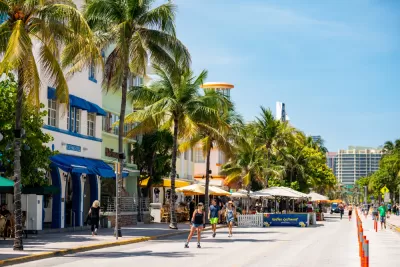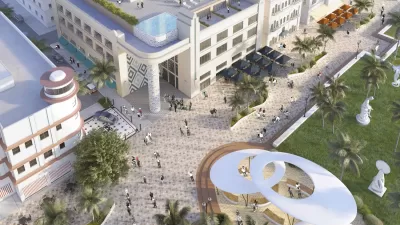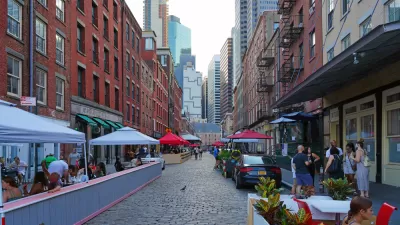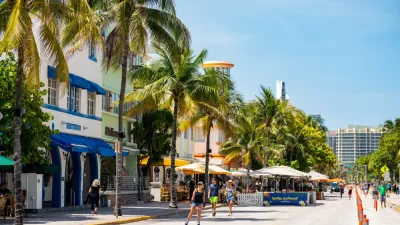Ocean Drive in South Beach is the site of an ongoing pilot project in making space for pedestrians and businesses in space previously devoted to cars. Advocates and some local politicians don't like the direction that the experiment is headed.

"For nearly eight weeks, a sliver of South Beach belonged to the people," writes Martin Vassolo. "There were no cars allowed on a 10-block stretch of Ocean Drive, the popular seaside promenade, giving bicyclists, skateboarders, joggers and walkers a space to exercise away from cramped sidewalks and congested roads."
Now that has changed, however, after the city returned cars to the northbound lanes on Ocean Drive over the 4th of July weekend, while retaining the southbound lanes for pedestrians and outdoor dining, in what promises to be an ongoing experiment in reconfiguring the public realm in response to ongoing crises of public health and the local economy.
"Mayor Dan Gelber said the street’s new configuration will not be permanent, calling it a 'two-week pilot' program," according to Vassolo. "Ideally, he said, the city should be able to fully pedestrianize the street during certain periods, and open it to cars the rest of the time."
Activists, however, are still pushing back on the decision to allow cars back onto the street. "Activists aren’t the only ones perplexed by the city’s decision to reopen Ocean Drive. Commissioners Ricky Arriola and Mark Samuelian, who supported the closure of the street, said on Friday they were not consulted about the plan," reports Vassolo.
Additional coverage of the ongoing Ocean Drive saga is available from Joshua Ceballos.
FULL STORY: Ocean Drive was closed to cars for eight weeks. Miami Beach is reopening a lane of traffic

Study: Maui’s Plan to Convert Vacation Rentals to Long-Term Housing Could Cause Nearly $1 Billion Economic Loss
The plan would reduce visitor accommodation by 25,% resulting in 1,900 jobs lost.

North Texas Transit Leaders Tout Benefits of TOD for Growing Region
At a summit focused on transit-oriented development, policymakers discussed how North Texas’ expanded light rail system can serve as a tool for economic growth.

Why Should We Subsidize Public Transportation?
Many public transit agencies face financial stress due to rising costs, declining fare revenue, and declining subsidies. Transit advocates must provide a strong business case for increasing public transit funding.

How to Make US Trains Faster
Changes to boarding platforms and a switch to electric trains could improve U.S. passenger rail service without the added cost of high-speed rail.

Columbia’s Revitalized ‘Loop’ Is a Hub for Local Entrepreneurs
A focus on small businesses is helping a commercial corridor in Columbia, Missouri thrive.

Invasive Insect Threatens Minnesota’s Ash Forests
The Emerald Ash Borer is a rapidly spreading invasive pest threatening Minnesota’s ash trees, and homeowners are encouraged to plant diverse replacement species, avoid moving ash firewood, and monitor for signs of infestation.
Urban Design for Planners 1: Software Tools
This six-course series explores essential urban design concepts using open source software and equips planners with the tools they need to participate fully in the urban design process.
Planning for Universal Design
Learn the tools for implementing Universal Design in planning regulations.
City of Santa Clarita
Ascent Environmental
Institute for Housing and Urban Development Studies (IHS)
City of Grandview
Harvard GSD Executive Education
Toledo-Lucas County Plan Commissions
Salt Lake City
NYU Wagner Graduate School of Public Service





























